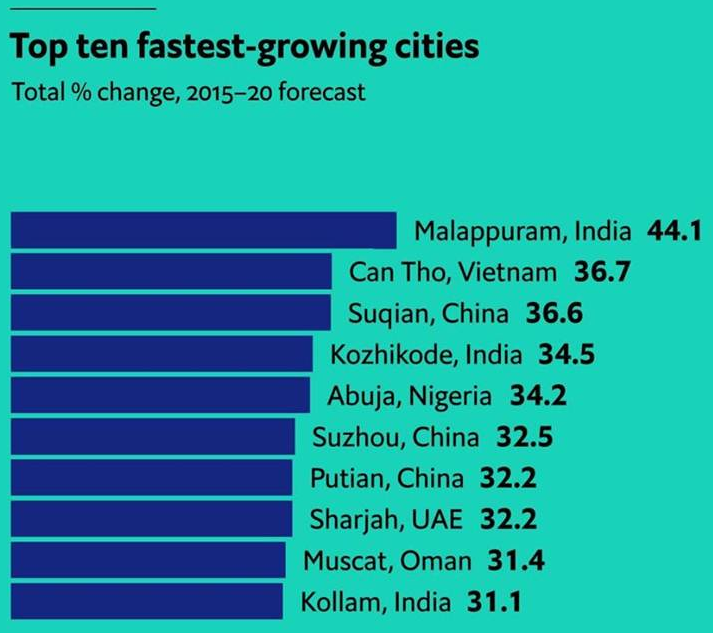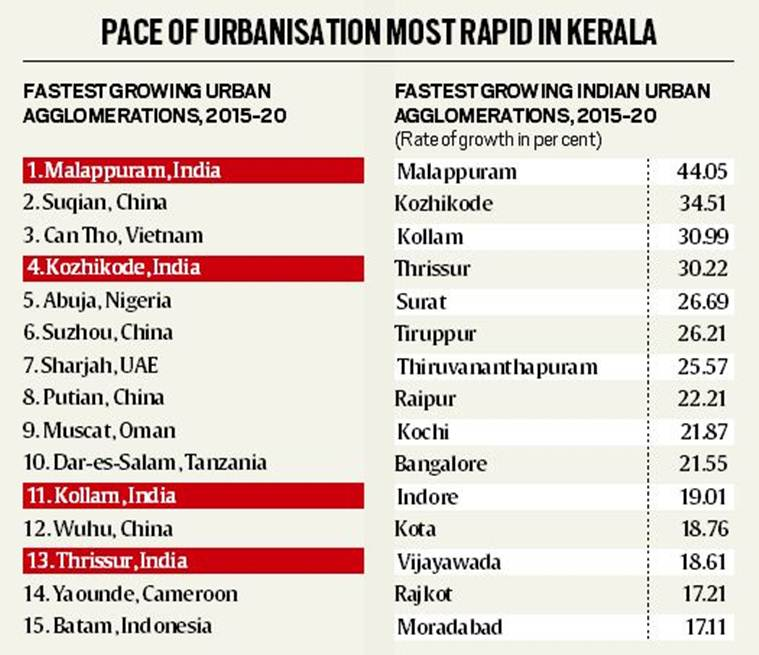Urbanisation Trends: EIU | 14 Jan 2020
Why in News
Recently, the Economist Intelligence Unit (EIU) survey released a ranking of the fastest-growing urban areas across the world which features three cities from Kerala among the top 10.
- From the period of 2015-2020, Malappuram had 44.1% change, Kozhikode had 34.5% change and Kollam had 31.1% change). These are the only places from India to feature in the top 10 rankings.
- Thrissur, Kerala is at 13th position with 30.2% jump between 2015 and 2020. Tiruppur, Tamil Nadu is at 30th rank. Thiruvananthapuram is at 33rd position.
Key Points
- Data: The list is based on data from the United Nations Population Division.
- Time Period: The Economist has listed the rate at which the populations of the UAs are expected to increase between 2015 and 2020 and it provides a measure of the pace of urbanisation.
- Unusual Findings: The rankings seem unusual because the total fertility rate (TFR, the number of children a woman is likely to have in the childbearing age of 15-49) in Kerala is 1.8 as per NITI Aayog data from 2016, below the replacement rate of 2.1.
With Reference to Kerala
- Transformation of Villages to Town: Kerala has low fertility rate which means the increase in the population of Malappuram and other cities is not because women are having more children but because more villages are being transformed into towns and city borders are expanding.
- When a village becomes a census town, its population is included in the urban population of the district.
- Cities of Kerala are seeing rapid urbanisation and the main reason is the inclusion of new areas in the UA’s limits.
- Effects of Migration: Kerala sees both emigration (migration from the state to other places) and immigration (the migration of workers to the state)
- The remittances that emigrants send allow the residents of villages to move away from agriculture, which changes the status of a village to census town.
- Shift from Agriculture: In Kerala, urbanisation is driven by a move away from agriculture, which leads to a change in a village’s Census classification status.
Factors for Population Growth
- When the birth rate exceeds the death rate (natural growth).
- When workers migrate to the city in search of jobs.
- When more areas get included within the boundaries of the city.
- When existing rural areas are reclassified as urban.
- According to the Census definition, an urban area is either a census town (CT) or a statutory town (ST).
- Statutory Town: Any place with a municipal corporation, municipal council, or cantonment board.
- Census Town: It can be a place with “urban characteristics”, a population of more than 5,000, population density more than 400 people per sq km, and with more than 75% of the population not engaged in agriculture for their livelihood.
- According to the UN, “urban agglomerations” (UA) are defined as continuous urban spread consisting of a town and its adjoining urban outgrowths or two or more physically contiguous towns together.
- For example, the National Capital Territory of Delhi is a UA that includes the Municipal Corporation of Delhi (MCD) and New Delhi Municipal Council (NDMC) areas as well as 107 census towns (erstwhile surrounding villages where more than 75% of the population is now engaged in non-agricultural pursuits).
Economist Intelligence Unit
- It is the research and analysis division of The Economist Group and the world leader in global business intelligence. It was created in 1946.
Way Forward
- Urbanisation leads to the growth of cities and infrastructure which gives more opportunities to youth. People leave behind caste and class divisions (to some extent) that dominate life in the villages and move upwards in society.
- However, unplanned urbanisation can be exclusionary making it difficult for migrants to live there given the high cost. Unregulated housing, lack of reliable public transport, and longer commutes within these towns put a strain on the meagre resources of migrants

